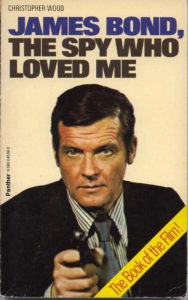Bond. James Bond. Is there a name more synonymous with spying, tuxedos, and shaken cocktails than the British secret agent? Join me as I read all of the James Bond books in 007 Case Files, encompassing Ian Fleming and beyond. For Your Eyes Only: there’s potential spoilers ahead.
Wait, haven’t we already been through this? Didn’t Ian Fleming release this back in 1962? The answers are “kind of” and “yes” respectively, although this book is a beast far removed from the often controversial The Spy Who Loved Me.
You might recall that Fleming’s novel of a similar name was unique among his Bond releases: it was told from the perspective of a woman, and barely featured 007 at all. So disappointed was Fleming with the results and criticisms that he tried to halt future releases of it. The 1977 film is an adaptation in name only, with co-screenwriter Christopher Wood novelising his screenplay (with Richard Maibaum) for mass publication. Hence, this is called JAMES BOND, THE SPY WHO LOVED ME to differentiate it from the original.
Still with me? The short version is that this follows the plot of the Lewis Gilbert film, starring Roger Moore in his third (and arguably best) outing as James Bond. It concerns the villain Karl Stromberg (alliteratively called Sigmund Stromberg here) wanting to destroy the world and start a new civilisation…under the sea (where there’s no accusations, just friendly crustaceans). Bond must team up with the unsurprisingly attractive Russian agent, Anya Amasova, to stop the ingenious ichthyophiliac.
As the first regular Bond novel since Kingsley Amis’ Colonel Sun, the fictional 1973 “autobiography” notwithstanding, Wood adopts a lot of Fleming’s literary tics, from the preciseness of ordering a martini, to Bond’s obsession with scrambled eggs, and even his ability to withstand genital torture. In fact, he really wants us to know he’s done his homework, directly referencing Casino Royale, On Her Majesty’s Secret Service, From Russia With Love, and many others. Yet Fleming was never quite as flamboyant with his words as Wood. From the opening pages, covering the “pre-credits” content of the film, Wood makes it clear that he’s more of a fan of purple prose than his predecessors.

The Spy Who Loved Me was Fleming’s most sexually explicit book he’d written at the time of release, but Wood amps this up significantly from the first page. The then-unnamed “girl” looks down at the “innocent swelling of her breasts beneath the sheets” and becomes ashamed when she “felt herself becoming hot and moist…because she was not a promiscuous girl.” Women in casinos, we are told, are either “straightforward whores or have run out of money,” and one such woman has a “dark gypsy slutishness tamed into sophistication.” A sex positive book this is not.
In the innocent/“whore” dichotomy of Wood’s world, women are a sum of their ornately described body parts, with Wood having a strange fixation on nipples: they are usually hard, erect or simply “jutting out from the arrogant breasts” (and sometimes just “jutted out proudly” or “expectantly” at other moments). Who knew nipples were so emotional? Other breasts are “firm and ripe” with nipples like “plump, juicy antennae.” Are we sure Wood wasn’t just taking notes in a supermarket?
Yet as a companion to the film, there’s a lot of fun to be had here. Stromberg’s past and motivations get a lot more fleshed out than in the film, and SMERSH is a lot more present here than in the film. (One argument for this is that the producers were conscious of ensuring nothing SPECTRE related was present, given the relative recency of Kevin McClory’s Thunderball case). Most fascinating is the entire backstory for fan-favourite villain (and later anti-hero) Jaws, whose real name turns out to be Zbigniew Krycsiwiki, the product of a union between a circus strong man and the Chief Warden at a Women’s Prison. In a single page, the character becomes richer – we know he played basketball, was arrested by the secret police, and his jaw destroyed and rebuilt.
Up until this point, nobody did it better than Fleming when it came to pure blunt-force Bond. Yet Wood’s take on the character is one of the best since Fleming’s death, and arguably better than anything Fleming did in his declining years.
James Bond will return in… James Bond and Moonraker (redux).





